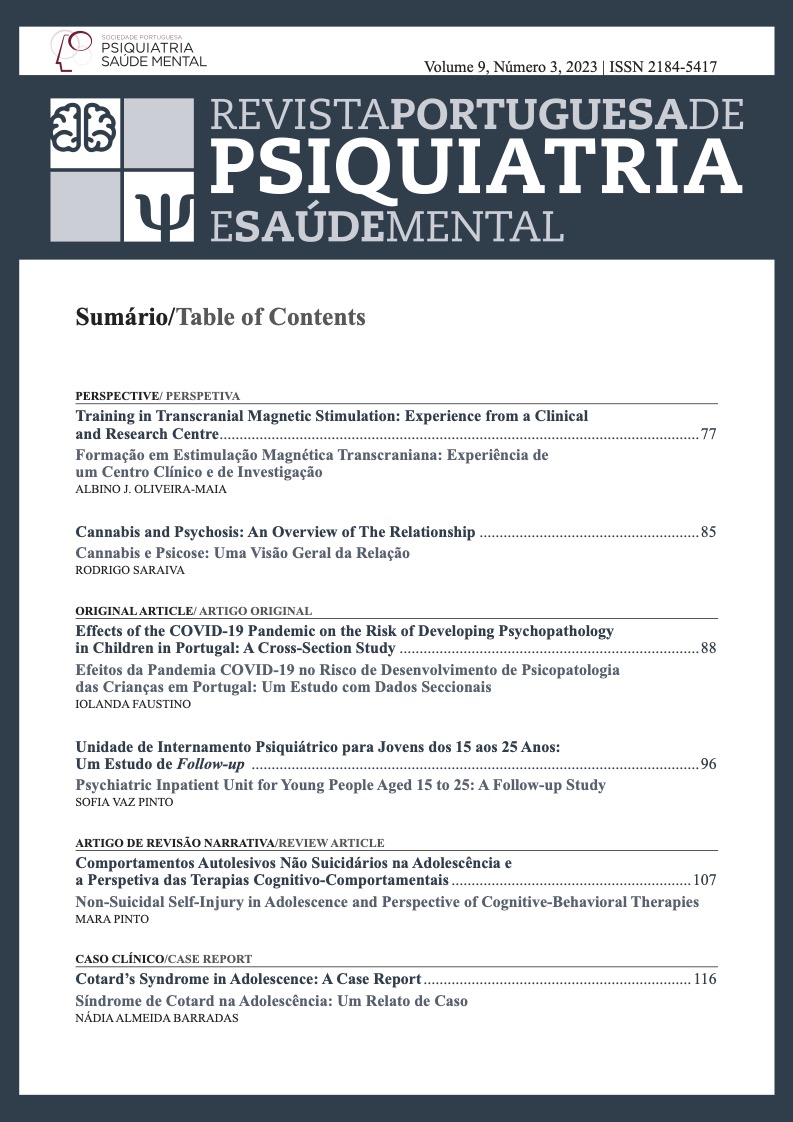Comportamentos Autolesivos Não Suicidários na Adolescência e a Perspetiva das Terapias Cognitivo-Comportamentais
DOI:
https://doi.org/10.51338/rppsm.390Palavras-chave:
Adolescente, Comportamentos Autolesivos/tratamento, Fatores de Risco, Terapia Cognitivo-ComportamentalResumo
Os comportamentos autolesivos, sejam eles suicidários ou não suicidários, constituem atualmente um incontornável problema de saúde pública, pela sua elevada incidência e impacto. Os comportamentos autolesivos não suicidários
são mais comuns na fase da adolescência, mesmo em jovens com um desenvolvimento normativo. A sua prevalência
é, contudo, consideravelmente superior na população clínica, com 50% a 60% dos adolescentes com psicopatologia
a apresentar episódios únicos ou repetidos de comportamentos autolesivos não suicidários. Estes comportamentos podem associar-se a mais do que uma causa e função, em resultado da interação entre múltiplos fatores de risco e de manutenção, como por exemplo, genéticos, biológicos, psiquiátricos, psicológicos, sociais e culturais. A prevalência significativa de comportamentos autolesivos não suicidários na população clínica e os desafios associados à abordagem destes jovens, seja numa componente de avaliação ou de intervenção, contribuem para a pertinência desta revisão narrativa cujos objetivos são a caracterização destes comportamentos e, por outro lado, a pesquisa de evidência sobre a vertente de avaliação e intervenção na perspetiva das terapias cognitivo-comportamentais.
Downloads
Referências
Guerreiro DF, Cruz D, Frasquilho D, Santos JC, Figueira ML, Sampaio D. Association Between Deliberate Self-Harm and Coping in Adolescents: A Critical Review of the Last 10 Years’ Literature. Arch Suicide Res. 2013;17: 91–105. doi:10.1080/13811118.2013.776439 DOI: https://doi.org/10.1080/13811118.2013.776439
Brown RC, Plener PL. Non-suicidal Self-Injury in Adolescence. Curr Psychiatry Rep. 2017;19:20. doi: 10.1007/s11920-017-0767-9. DOI: https://doi.org/10.1007/s11920-017-0767-9
Plener PL, Kaess M, Schmahl C, Pollak S, Fegert JM, Brown RC. Non-suicidal self-injury in adolescents. Dtsch Arztebl Int. 2018;115:23-30. doi: 10.3238/ arztebl.2018.0023.
Moran P, Coffey C, Romaniuk H, Olsson C, Borschmann R, Carlin JB, et al. The natural history of self-harm from adolescence to young adulthood: A population-based cohort study. Lancet. 2012;379: 236–43. doi:10.1016/S0140-6736(11)61141-0 DOI: https://doi.org/10.1016/S0140-6736(11)61141-0
Plener PL, Schumacher TS, Munz LM, Groschwitz RC. The longitudinal course of non-suicidal self-injury and deliberate self-harm: A systematic review of the literature. Borderline Personal Disord Emot Dysregul. 2015;2:2. doi: 10.1186/s40479-014-0024-3. DOI: https://doi.org/10.1186/s40479-014-0024-3
Gaspar S, Reis M, Sampaio D, Guerreiro D, de Matos MG. Non-suicidal Self-Injuries and Adolescents High Risk Behaviours: Highlights from the Portuguese HBSC Study. Child Indic Res. 2019;12: 2137–49. doi:10.1007/s12187-019-09630-w DOI: https://doi.org/10.1007/s12187-019-09630-w
American Psychiatric Association. Diagnostic and Statistical Manual of Mental Disorders. 5th ed. Chicago: American Psychiatric Association; 2013. doi:10.1176/ appi.books.9780890425596 DOI: https://doi.org/10.1176/appi.books.9780890425596
Xiao Q, Song X, Huang L, Hou D, Huang X. Global prevalence and characteristics of non-suicidal self-injury between 2010 and 2021 among a non-clinical sample of adolescents: A meta-analysis. Front Psychiatry. 2022;13. doi:10.3389/FPSYT.2022.912441 DOI: https://doi.org/10.3389/fpsyt.2022.912441
Madge N, Hewitt A, Hawton K, Wilde EJ De, Corcoran P, Fekete S, et al. Deliberate self-harm within an international community sample of young people: Comparative findings from the Child & Adolescent Self-harm in Europe (CASE) Study. J Child Psychol Psychiatry Allied Discip. 2008;49: 667–77. doi:10.1111/j.1469-7610.2008.01879.x DOI: https://doi.org/10.1111/j.1469-7610.2008.01879.x
Gillies D, Christou MA, Dixon AC, Featherston OJ, Rapti I, Garcia-Anguita A, et al. Prevalence and Characteristics of Self-Harm in Adolescents: Meta-Analyses of Community-Based Studies 1990–2015. J Am Acad Child Adolesc Psychiatry. 2018;57:733-41. doi: 10.1016/j.jaac.2018.06.018. DOI: https://doi.org/10.1016/j.jaac.2018.06.018
Kaess M, Parzer P, Mattern M, Plener PL, Bifulco A, Resch F, et al. Adverse childhood experiences and their impact on frequency, severity, and the individual function of nonsuicidal self-injury in youth. Psychiatry Res. 2013;206: 265272. doi:10.1016/j.psychres.2012.10.012 DOI: https://doi.org/10.1016/j.psychres.2012.10.012
Matos MG, Simões C, Tomé G, Camacho I, Ferreira M, Ramiro L, et al. A Saúde dos Adolescentes Portugueses - Relatório do Estudo HBSC 2010. Lisboa: HBSC; 2011.
Matos MG, Simões C, Reis M. A Saúde dos Adolescentes Portugueses em tempos de recessão - Relatório do Estudo HBSC 2014. Lisboa: HBSC; 2015.
Guerreiro DF, Sampaio D, Figueira ML, Madge N. Self-Harm in Adolescents: A Self-Report Survey in Schools from Lisbon, Portugal. Arch Suicide Res. 2017;21: 83–99. doi:10.1080/13811118.2015.1004480 DOI: https://doi.org/10.1080/13811118.2015.1004480
Guerreiro DF, Sampaio D, Rihmer Z, Gonda X, Figueira ML. Affective temperaments and self-harm in adolescents: A cross-sectional study from a community sample. J Affect Disord. 2013;151: 891–8. doi:10.1016/j.jad.2013.07.034 DOI: https://doi.org/10.1016/j.jad.2013.07.034
Klonsky ED. The functions of deliberate self-injury: A review of the evidence. Clinical Psychology Review. Clin Psychol Rev. 2007; 226–39. doi:10.1016/j. cpr.2006.08.002 DOI: https://doi.org/10.1016/j.cpr.2006.08.002
Nock MK, Prinstein MJ. A functional approach to the assessment of self-mutilative behavior. J Consult Clin Psychol. 2004;72: 885–90. doi:10.1037/0022-006X.72.5.885 DOI: https://doi.org/10.1037/0022-006X.72.5.885
Glenn CR, Klonsky ED. Prospective Prediction of Nonsuicidal Self-Injury: A 1-Year Longitudinal Study in Young Adults. Behav Ther. 2011;42: 751–62. doi:10.1016/j.beth.2011.04.005 DOI: https://doi.org/10.1016/j.beth.2011.04.005
Walsh B. Clinical assessment of self-injury: A practical guide. Journal of Clinical Psychology. J Clin Psychol. 2007: 1057–68. doi:10.1002/jclp.20413 DOI: https://doi.org/10.1002/jclp.20413
Garisch JA, Wilson MS, O’Connell A, Robinson K. Overview of assessment and treatment of non-suicidal self-injury among adolescents. NZ J Psychol. 2017;46: 98–105.
Faura-Garcia J, Orue I, Calvete E. Clinical assessment of non-suicidal self-injury: A systematic review of instruments. Clin Psychol Psychother. 2021;28: 739–65. doi:10.1002/CPP.2537 DOI: https://doi.org/10.1002/cpp.2537
Hooley JM, Fox KR, Boccagno C. Nonsuicidal Self-Injury: Diagnostic Challenges And Current Perspectives. Neuropsychiatr Dis Treat. 2020;16: 101. doi:10.2147/NDT.S198806 DOI: https://doi.org/10.2147/NDT.S198806
Linehan MM, Comtois KA, Brown MZ, Heard HL, Wagner A. Suicide Attempt Self-Injury Interview (SASII): Development, reliability, and validity of a scale to assess suicide attempts and intentional self-injury. Psychol Assess. 2006;18: 303–12. doi:10.1037/1040-3590.18.3.303 DOI: https://doi.org/10.1037/1040-3590.18.3.303
Nock MK, Holmberg EB, Photos VI, Michel BD. Self-Injurious Thoughts and Behaviors Interview: Development, Reliability, and Validity in an Adolescent Sample. Psychol Assess. 2007;19: 309–17. doi:10.1037/1040-3590.19.3.309 DOI: https://doi.org/10.1037/1040-3590.19.3.309
Osman A, Bagge CL, Gutierrez PM, Konick LC, Kopper BA, Barrios FX. The suicidal behaviors questionnaire-revised (SBQ-R): Validation with clinical and nonclinical samples. Assessment. 2001;8: 443–54. doi:10.1177/107319110100800409 DOI: https://doi.org/10.1177/107319110100800409
Campos RC, Holden RR. Portuguese Version of the Suicidal Behaviors Questionnaire-Revised: Validation Data and the Establishment of a Cut-Score for Screening Purposes. Eur J Psychol Assess. 2019;35: 190–5. doi:10.1027/1015-5759/a000385 DOI: https://doi.org/10.1027/1015-5759/a000385
Klonsky ED, Glenn CR. Assessing the Functions of Non-suicidal Self-injury: Psychometric Properties of the Inventory of Statements about Self-injury (ISAS). J Psychopathol Behav Assess. 2009;31: 215–9. doi:10.1007/s10862-008-9107-z DOI: https://doi.org/10.1007/s10862-008-9107-z
Duarte E, Gouveia-Pereira M, Gomes HS. Development and Factorial Validation of the Inventory of Deliberate Self-Harm Behaviours for Portuguese Adolescents. Psychiatr Q. 2019;90: 761–76. doi:10.1007/ s11126-019-09660-1 DOI: https://doi.org/10.1007/s11126-019-09660-1
Izadi-Mazidi M, Yaghubi H, Mohammadkhani P, Hassanabadi H. Assessing the functions of non-suicidal self-injury: Factor analysis of functional assessment of self-mutilation among adolescents. Iran J Psychiatry. 2019;14: 184–91. doi:10.18502/ijps.v14i3.1319 DOI: https://doi.org/10.18502/ijps.v14i3.1319
Gratz KL. Measurement of deliberate self-harm: Preliminary data on the deliberate self-harm inventory. J Psychopathol Behav Assess. 2001;23: 253–63. doi:10.1023/A:1012779403943 DOI: https://doi.org/10.1037/t04163-000
Latimer S, Covic T, Cumming SR, Tennant A. Psychometric analysis of the Self-Harm Inventory using Rasch modelling. BMC Psychiatry. 2009;9: 1–9. doi:10.1186/1471-244X-9-53 DOI: https://doi.org/10.1186/1471-244X-9-53
Washburn JJ, Juzwin KR, Styer DM, Aldridge D. Measuring the urge to self-injure: Preliminary data from a clinical sample. Psychiatry Res. 2010;178: 540–4. doi:10.1016/j.psychres.2010.05.018 DOI: https://doi.org/10.1016/j.psychres.2010.05.018
Vrouva I, Fonagy P, Fearon PRM, Roussow T. The risk-taking and self-harm inventory for adolescents: Development and psychometric evaluation. Psychol Assess. 2010;22: 852–65. doi:10.1037/a0020583 DOI: https://doi.org/10.1037/a0020583
Xavier A, Cunha M, Pinto-Gouveia J. Validation of the Risk-Taking and Self-Harm Inventory for Adolescents in a Portuguese Community Sample. Meas Eval Couns Dev. 2019;52: 1-14. doi: 10.1080/07481756.218.1435189 DOI: https://doi.org/10.1080/07481756.2018.1435189
Carvalho CB, Nunes C, Castilho P, da Motta C, Caldeira S, Pinto-Gouveia J. Mapping non suicidal self-injury in adolescence: Development and confirmatory factor analysis of the impulse, self-harm and suicide ideation questionnaire for adolescents (ISSIQ-A). Psychiatry Res. 2015;227: 238–45. doi:10.1016/j. psychres.2015.01.031 DOI: https://doi.org/10.1016/j.psychres.2015.01.031
Chávez-Flores YV, Hidalgo-Rasmussen CA, Yanez-Peñúñuri LY. Assessment tools of non-suicidal self-injury in adolescents 1990-2016: A systematic review. Ciencia Saude Coletiva. 2019; 2871–82. doi:10.1590/1413-81232018248.18502017 DOI: https://doi.org/10.1590/1413-81232018248.18502017
Kress V, Hoffman R. Non-Suicidal Self-Injury and Motivational Interviewing: Enhancing Readiness for Change. J Ment Heal Couns. 2008;30: 311–29. doi:10.17744/mehc.30.4.n2136170r5732u6h DOI: https://doi.org/10.17744/mehc.30.4.n2136170r5732u6h
Witt KG, Hetrick SE, Rajaram G, Hazell P, Taylor Salisbury TL, Townsend E, et al. Interventions for self-harm in children and adolescents. Cochrane Database Syst Rev. 2021;3:CD013667. doi: 10.1002/14651858. CD013667.pub2. DOI: https://doi.org/10.1002/14651858.CD013667.pub2
Ougrin D, Tranah T, Stahl D, Moran P, Asarnow JR. Therapeutic interventions for suicide attempts and self-harm in adolescents: Systematic review and meta-analysis. J Am Acad Child Adolesc Psychiatry. 2015;54:97-107.e2. doi: 10.1016/j.jaac.2014.10.009. DOI: https://doi.org/10.1016/j.jaac.2014.10.009
Washburn JJ, Richardt SL, Styer DM, Gebhardt M, Juzwin KR, Yourek A, et al. Psychotherapeutic approaches to non-suicidal self-injury in adolescents. Child Adolesc Psychiatry Ment Health. 2012;6: 14. doi:10.1186/1753-2000-6-14 DOI: https://doi.org/10.1186/1753-2000-6-14
Bettis AH, Liu RT, Walsh BW, Klonsky ED. Treatments for Self-Injurious Thoughts and Behaviors in Youth: Progress and Challenges. Evidence-based Pract child Adolesc Ment Heal. 2020;5: 354. doi:10.1080/23 794925.2020.1806759 DOI: https://doi.org/10.1080/23794925.2020.1806759
Kaess M, Edinger A, Fischer-Waldschmidt G, Parzer P, Brunner R, Resch F. Effectiveness of a brief psychotherapeutic intervention compared with treatment as usual for adolescent nonsuicidal self-injury: a single-centre, randomised controlled trial. Eur Child Adolesc Psychiatry. 2020;29: 881–91. doi:10.1007/ s00787-019-01399-1 DOI: https://doi.org/10.1007/s00787-019-01399-1
Mehlum L, Ramberg M, Tørmoen AJ, Haga E, Diep LM, Stanley BH, et al. Dialectical Behavior Therapy Compared with Enhanced Usual Care for Adolescents with Repeated Suicidal and Self-Harming Behavior: Outcomes over a One-Year Follow-Up. J Am Acad Child Adolesc Psychiatry. 2016;55: 295–300. doi:10.1016/j.jaac.2016.01.005 DOI: https://doi.org/10.1016/j.jaac.2016.01.005
DeCou CR, Comtois KA, Landes SJ. Dialectical Behavior Therapy Is Effective for the Treatment of Suicidal Behavior: A Meta-Analysis. Behav Ther. 2019;50: 60–72. doi:10.1016/j.beth.2018.03.009 DOI: https://doi.org/10.1016/j.beth.2018.03.009
Asarnow JR, Berk MS, Bedics J, Adrian M, Gallop R, Cohen J, et al. Dialectical Behavior Therapy for Suicidal Self-Harming Youth: Emotion Regulation, Mechanisms, and Mediators. J Am Acad Child Adolesc Psychiatry. 2021;60:1105-15.e4. doi: 10.1016/j. jaac.2021.01.016. DOI: https://doi.org/10.1016/j.jaac.2021.01.016
Pardo ES, Rivas AF, Barnier PO, Mirabent MB, Lizeaga IK, Cosgaya AD, et al. A qualitative research of adolescents with behavioral problems about their experience in a dialectical behavior therapy skills training group. BMC Psychiatry. 2020;20:245. doi:10.1186/ S12888-020-02649-2/FIGURES/1 DOI: https://doi.org/10.1186/s12888-020-02649-2
Mehlum L. Mechanisms of change in dialectical behaviour therapy for people with borderline personality disorder. Curr Opin Psychol. 2021;37: 89–93. doi:10.1016/J.COPSYC.2020.08.017 DOI: https://doi.org/10.1016/j.copsyc.2020.08.017
Van KJ, Geneviève V, Kalnins RC, Van Vliet K, Kalnins G. A Compassion-Focused Approach to Nonsuicidal Self-Injury. J Ment Heal Couns. 2011. doi:10.17744/ MEHC.33.4.J7540338Q223T417 DOI: https://doi.org/10.17744/mehc.33.4.j7540338q223t417








